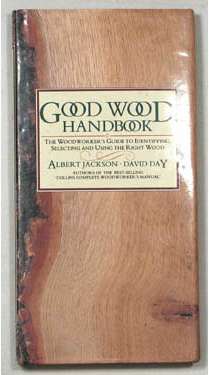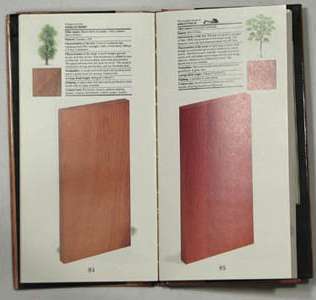
TITLE: The Good Wood Handbook
SUBTITLE: The Woodworker's Guide to Identifying, Selecting and Using the Right Wood
AUTHOR(s): Albert Jackson and David Day
PUBLISHER / DATE: Betterway Publications, 1992 [this is the first edition; there is a revised 2nd edition which I do not have]
ISBN-10: 1-55870-274-1
ISBN-13: 9781558702745
PRICE NEW: $17
PRICE RANGE USED/NEW: $2 to $80 (I've seen it new for $15 or so even though it's out of print and you COULD pay $150 for it as a rare book, but that would be really dumb.)

The first thing I want to say about this book is that when it comes to photographs of wood in books about wood, this book is the absolute gold standard.
This very slim, thin volume is worth far more than the price. It is a simply outstanding compilation of information about 74 readily available species of commonly used wood, plus extensive and highly informative sections on veneer and man-made wood products such as plywood and hardboard. Although the text regarding each of the 74 woods discussed is limited, what's there is uniformly useful, pertinent, and correct. The pics are not just unexcelled in any book that I am aware of that has ever been published on wood, even better is this: I don't see how they COULD be excelled since you can't really improve on perfection. I have been charitable about the pics in other books to the extent that I have said things about how the printing process can be blamed for some of the lack of color correctness, but this book absolutely puts the lie to any thought that such a limitation cannot be avoided.
Further, the choice of wood samples and the manner of their preparation and the specifics of the photography (neither too far away nor too close up) all lead to the most representative set of wood pics that I have ever seen all in one place outside of my own web site, and that is an understatement of the books excellence, because my site has thousands of pics and this book has 74. I really take my hat off to the folks who planned and executed this set of pics. For some of the species shown here, it is true that NONE of the many pics on my site is as good as their one single pic. On a few of the wood (bubinga and padauk come immediately to mind) you get a much better feel for the wood by looking at the multiple pics on my site but for most of them, my site is only good for showing you the end grain closeup which this book doesn't include.
The ONLY nit I could find to pick with the pics is the fairly serious one there are no end-grain pics (this is somewhat mitigated by the fact that the end grain shows up a little in the pics that are presented).
There are introductory sections, fairly brief but highly informative, about how trees grow, how they get converted into useable forms, how wood is graded, some of the fundamental properties of wood. This is a small book and these are only a couple of pages each but there is a wealth of good solid information packed into a small space. Then there is a section on softwoods followed by another on hardwoods and then the sections on veneer and man-made wood products.
The wood characteristics discussed include other names, tree characteristics, wood characteristics, workability, average dried weight, finishing properties, and common uses.
As regards the text about the wood, I have two minor complaints and two more significant ones and all of these are about limitations, not lack of correctness. The first minor caveat is that there is no mention of toxicity, but then of the 74 woods, only a couple are ones for which this is an issue and wood toxicity charts are not hard to find these days on the internet. The second minor complaint is that weights are given as an average whereas I believe it is much more useful to give a range, especially for those woods for which the range is considerable and the average cannot be relied on (purpleheart, for example, being a very prominent example of that, as is discussed on my site).
More significant for the woodworker is the lack of comments on nailing and screwing characteristics of the individual woods, although the section on plywood and man-made wood does discuss screwing characteristics of many of those products. Further, there is nothing on stability and shrinkage, another important topic for wood craft.
Porosity is not mentioned except indirectly, but that indirect mention is all about what's most important; the ability of the wood to take various finishing agents and the ability to take a high polish or not. This is not a book on wood identification, so characteristics such as ring porous and diffuse porous are not mentioned.
In terms of general discussions, the ONLY nit I could pick with the entire 74-wood set is that the discussion on American white oak does not mention cooperage, which is one of the two salient characteristics of white oak (strong ray flakes being the other). This is, for me, an astoundingly small number of nits for me to pick even for so small a book. On any other book even of this small size I would mention a half-dozen and have many more that I didn't bother to mention. These guys really know what they're talking about.
The book is written in British English, as opposed to American English but this is irrelevant except for a couple of spellings because even the use of "burr" rather than "burl" is accompanied by "burl" in parentheses.
The only serious complaint I have about this book is that it is WAY WAY WAY too short! I wish the authors had done for 250 woods what they did for 74, with about twice the amount of discussion on each wood. If they had done that, most (if not all) of the other books on wood as a material could just be tossed out as unneeded.
Overall grade, A (the text is an A-, and only misses a solid A because of limitations not because of any lack of correctness, and the pics are A++, but the lack of end grain shots reduces the pic grade down to an A+)

